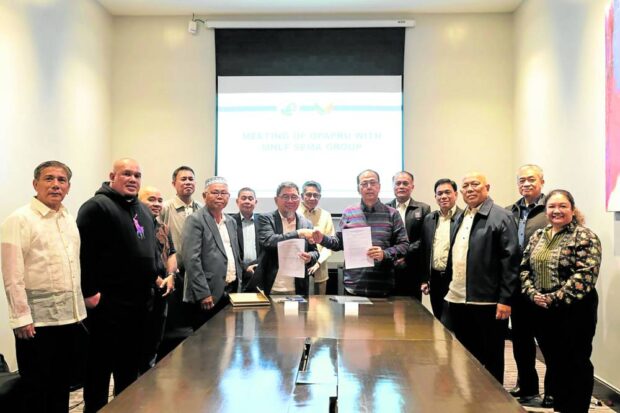After 20-year split, MNLF factions unite for peace

WORKING TOGETHER Bangsamoro Labor Minister Muslimin Sema, along with top leaders of a faction of the Moro National Liberation Front, presents a resolution to Presidential Peace Adviser
Carlito Galvez Jr. on Tuesday signifying, among others, their intent to work with the faction led by Nur Misuari in the implementation of the 1996 peace accord. —PHOTO COURTESY OF OFFICE OF THE PRESIDENTIAL ADVISER ON PEACE, RECONCILIATION AND UNITY
ILIGAN CITY—The two factions of the erstwhile revolutionary group Moro National Liberation Front (MNLF) have agreed to work together to push for the development of their once stronghold communities and the rest of the Bangsamoro region.
According to Presidential Peace Adviser Carlito Galvez Jr., the idea for a “convergence” came up during his separate meetings with the MNLF factions on how to strengthen their collaboration in implementing the unfulfilled aspects of the Final Peace Agreement (FPA) that the parties signed in 1996.
Galvez first met on Monday with the faction led by MNLF founding chair Nur Misuari. For the MNLF side, the meeting was led by Misuari’s son, Bangsamoro Parliament Deputy Speaker Ustadz Abdulkarim Tan Misuari. On Tuesday, he met with the faction headed by Bangsamoro Autonomous Region in Muslim Mindanao (BARMM) Labor Minister Muslimin Sema.
“Inspired by the convergence efforts in the Bangsamoro Transition Authority (BTA) with the MILF (Moro Islamic Liberation Front) and other sectors in the Bangsamoro, the MNLF-Misuari and MNLF-Sema groups have expressed their openness to pursue the convergence effort,” Galvez told the Inquirer on Thursday.
This is the first time that both factions agreed to work together to implement the 1996 peace accord since their split in 2001.
It will also give another shot in the arm to over a decade of encouragement by the Organization of Islamic Cooperation (OIC) for the Moro revolutionary fronts, including the MILF which also split from the MNLF in 1977, to unify their efforts for the Bangsamoro people. For that, the OIC shepherded the creation of the Bangsamoro Coordination Forum (BCF) in 2010.
The OIC has been a major backer of the Bangsamoro peace process since the mid-1970s and has committed to put up the Bangsamoro Development Assistance Fund for the rehabilitation of war-torn communities in Mindanao.
Opapru role
The factions had tasked the Office of the Presidential Adviser on Peace, Reconciliation and Unity (Opapru) to facilitate the union.
“As a vehicle for convergence, a Joint MNLF Executive Committee shall be established to be represented by leaders of the two MNLF groups that shall provide policy guidance on convergence efforts,” a resolution from the MNLF-Sema faction read.
Galvez said the decision of the MNLF factions to unify their actions laid the foundation for “the future reengagement with the OIC through the BCF.”
Galvez’s meetings with the MNLF factions early this week had led to the transformation of what used to be coordinating committees into implementing committees, signifying their active involvement in carrying out the FPA.
He said this development “is critical to ensure the harmonization of the programs and projects as part of the implementation of the peace agreement.”
Galvez said the engagement between the government and the MNLF groups was focused on the transformation of its former fighters, their families and communities to include those residing outside of the BARMM.
“These efforts to converge the MNLF and the implementation of socioeconomic programs for the MNLF communities is part of the Marcos administration’s desire that no one should be left behind in the peace process,” he stressed.
Presidential priority
Galvez said it was President Marcos who took on the task of bridging the Moro leaders.
“Just two months into his administration, he helped bridge and reconcile the Moro leaders, and appointed an inclusive [membership of the] BTA—ensuring an equitable composition of the Bangsamoro parliament, composed of young, forward-looking and development-oriented public servants, [who] aim to foster innovation in governance and, at the same time, ensure the meaningful inclusion of women,” he said.
Galvez said the intention of the Marcos administration “is to reconcile and unite the Moro groups in Mindanao and continue with the implementation of all signed Bangsamoro peace agreements.”
The younger Misuari said: “MNLF is one of the champions of peace. We will do our part to sanctify our agreements.”
He noted that the 1996 peace agreement laid the foundation for the expanded autonomous region and empowered the Bangsamoro people for self-governance within the BARMM.
“While changes remain, the FPA inspires us to continue pursuing lasting peace, building bridges of hope and addressing the root cause of conflict in the region,” Misuari added.